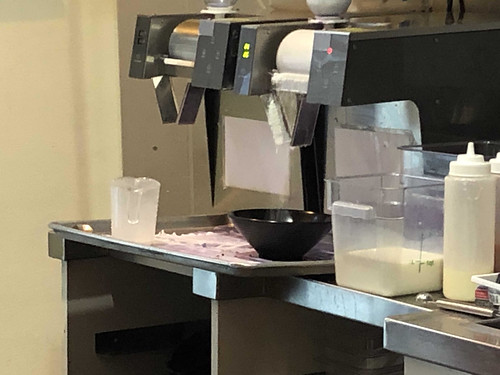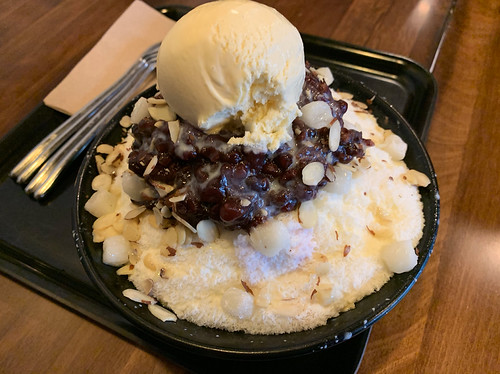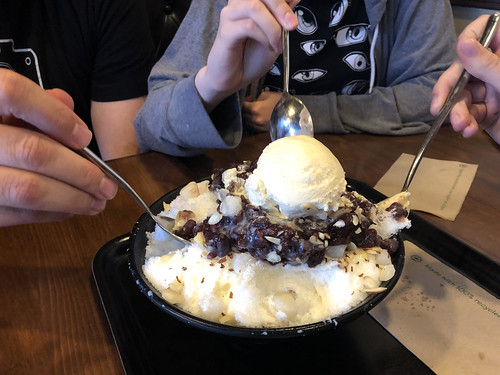Italians serve up silky gelato. In India, expect kulfi for an icy dessert. Mexico’s popsicle-like paletas come in endless fruit flavors. For Japanese, ice cream mochi encase spoonfuls of ice cream in flavors like sweet mango, green tea, strawberry and more in a thick, rice shell. Americans make towering sundaes with multiple scoops of ice cream drenched in hot fudge before being sprinkled with chopped nuts and topped with a sticky-sweet maraschino cherry.
Cultures throughout the world have their own twist on chilly desserts. And if you want to add another dessert to your summer, sweet tooth bucket list, patbingsu (also called bingsu) should definitely be on it. Haven’t heard of patbingsu? This popular dessert in Korea, and other parts of Asia, has made its way to specialty dessert shops around the world.

Photo courtesy Sweetang, adapted by Wandering Educators
Here are a few reasons you need to try patbingsu.
#5 Although you can make patbingsu at home, it’s better from a specialty shop.
Ice, sugared red beans, and milk, most often sweetened condensed milk – those are the basics of patbingsu. The dessert has been described as Korean shaved ice, but that doesn’t capture the fluffy consistency of patbingsu. The shaved ice looks like potato flakes – it’s light and powdery, not at all crystalline.
While there are ice shavers you can purchase to use at home (including a hand-crank variety), commercial shavers are able to whip up the characteristic ‘snow’ with greater consistency than what you could most likely make at home. Plus, patbingsu tends to be a social dessert, not a solitary one (see #1) so it’s worth seeking out a Korean eatery.

#4 Patbingsu has a long, sweet history.
This frozen dessert dates back more than 600 years. Patbingsu mentions pop up during Korea’s Joseon Dynasty, which lasted from 1392 to 1910. The story goes that government officials, tasked with taking care of the “royal ice box,” took advantage of the job, shaving some of the ice and topping it with fruit. Over time, the addition of sweet bean paste became a staple.
With Western influence came a reimagining of patbingsu with ingredients like a scoop of ice cream and more fruits. Individual eateries put their own spin on toppings, for example, my local patbingsu spot, Sweetang, offers some topped with Oreos and cheesecake.
#3 Patbingsu is ice cream elevated to an art form.
Creating patbingsu takes time. At Sweetang, once you order, the server pours milk into the icing machine to deliver a blizzard of milky flakes that fall in a cone shape into a chilled bowl. Our family tends to stick with the original – a tower of snow topped with sweetened red beans, a scoop of ice cream, slivered almonds and chunks of mochi.
Each patbingsu eatery seems to put their own spin on the classic dessert – whether it’s by adding cool ingredients, like melon balls added to create a swirling pattern or putting the snow into a cylinder shape to form new designs.

#2 Eating bingsu is a bit like eating a tasty science experiment.
I’m no bingsu expert, but what our family has discovered is that the flavor and texture of the patbingsu changes with each bite. The snowy milk flakes at first taste like you’re eating sweetened air. The flakes immediately dissolve in your mouth. But the longer you indulge in your patbingsu, the more the flakes melt into one another so that the dessert starts to have more of an ice cream consistency. The sweetened condensed milk pools more toward the bottom of the dish, too, so each bite gets sweeter the deeper you delve into the dessert.

#1 Sure, you can eat it alone, but patbingsu is better when you share.
You could certainly eat your patbingsu alone, but it’s more of an experience if you share. We’ve noticed other groups doing the same – patbingsu is an invitation to get together with someone and enjoy a dessert, together. At our favorite Korean dessert spot, there’s usually K-pop playing and at least one group is eating while playing board games.

For us, when the server brings the patbingsu to our table – a spoon at each corner of the tray, it’s almost like the start of the race. As soon as everyone has a spoon in hand (and they’ve taken a few shots to Snapchat) we dig in. I’ll admit, the goal is usually to see who can eat the most mochis since those tend to be the favorite – they look like marshmallows on the dish, but taste like chewy rice gummy bears.
Check out Eater’s discussion of all-things bingsu!
Kristen J. Gough, a Culinary Spelunker, is the Global Cuisines and Kids Editor for Wandering Educators
All photos courtesy and copyright Kristen J. Gough, except where noted.
